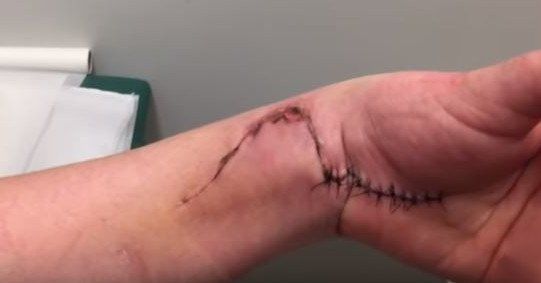Carpal Tunnel Surgery: Pain You Can Expect
Table of Contents
- Overview
- Incisional carpal tunnel surgery pain
- Pillar carpal tunnel surgery pain
- Other pain
- Infection pain
- Doctor-induced pain
- Persistent pain
- Summary
- FAQs
- About
Overview
Following your carpal tunnel surgery, pain can always be expected. But it's a
different kind of pain compared to the stabbing, aching, or nagging pain you felt with carpal tunnel syndrome.
As the anesthesia wears off after surgery, the pain may be a little more intense than other kinds of surgical procedures. It usually feels worse because the concentration of pain is in a smaller area (your palm). In addition, your hand and palm have
lots of nerve endings, making them the most sensitive body parts.
Without exception, all surgery results in pain. The degree of pain depends on the type of surgery you have. Generally, there is more pain as more (and different kinds of) tissues are disrupted.
The hand has many different types of tissues packed into a small area. Skin, tendons, muscles, bones, and ligaments are all disrupted during carpal tunnel surgery.
That's why carpal tunnel surgery pain is usually considered to be moderate to severe in the short term. The post-surgical pain usually lasts a few days and then slowly dissipates.
However,
complications and other factors can extend the pain much further. That means some degree of pain can last for weeks or months. In rarer cases, pain can drop to a lower level but never go away completely. Of course, any of this can increase your
carpal tunnel surgery recovery time to some extent.
Carpal tunnel surgery pain usually occurs as one of two different types:
incisional pain and
pillar pain. These are discussed below.
Incisional
carpal tunnel surgery pain
This type of pain comes from the actual cut skin and tissues below it. Basically, nerve endings are broken, which causes pain. In carpal tunnel surgery, disruption of a lot of different tissue layers occurs. So cutting through all of these layers (and nerves) is what produces the pain. It’s the same type of sharp, stinging pain you get if you cut your finger with a knife. But a knife usually only cuts your skin and not the tissues below.
Incisional pain typically only lasts a few days to a couple weeks at most.
Keeping the wound clean and avoiding lifting or gripping things helps lessen the pain. (And avoid other
harmful activities which can exacerbate the pain.) Also, keeping your hand elevated as much as possible reduces swelling and subsequent pain.
Incisional pain is greater with
open carpal tunnel release surgery. That’s because the cut is 2-3 inches long on the palm of your hand. Compare that to a half-inch cut made with
endoscopic carpal tunnel release surgery. The incisional pain is much less.
Pillar
carpal tunnel surgery pain
Pillar pain is different than incisional pain. This is pain emanates from the sides of the cut, on the two bumps in your lower palm. The pain most often occurs with the open carpal tunnel release surgery technique. It is much less common with endoscopic carpal tunnel surgery.
Actually, pillar pain occurs when a branch of the
median nerve is damaged. That branch runs to the skin on the palm. It is often cut or bruised during the surgery. This pain usually extends laterally from the incision. Pillar pain is considered a complication of the surgery.
Pillar pain is also the most often reported type of carpal tunnel surgery pain. It is also the most difficult type of pain to treat.
Other pain
• Infection pain
A potentially serious complication of carpal tunnel surgery is infection. The infection may be on the surface. But if it has reached down into the wrist, it’s much more serious. The doctor will take immediate action to keep the infection from spreading.
First, the doctor will order antibiotics. If the infection is severe, the doctor may perform another surgery to clean out the infection. Afterwards, a drainage tube is usually required for a few days. All of these add to the normal carpal tunnel surgery pain you already have.
• Doctor-induced pain
If there is any complication during surgery, the result can be additional pain. A good example is if the
doctor damages one or more blood vessels in the wrist. That means, in addition to the skin and ligament being cut, damaged blood vessels will cause their own, additional pain. This just amplifies the normal pain of the operation.
• Persistent pain
Finally, if the surgery was not successful, pain from carpal tunnel syndrome may persist or recur. In other words, your carpal tunnel pain may not have resolved after surgery. This is considered a failed surgery, which occurs
about 50% of the time. There are few options left for the patient at this point.
Between 10% and 60% of patients
with a second (“revision”) surgery have relief of symptoms if the first surgery failed. The remainder go on to live with the persistent pain and manage it as best they can. The wide-ranging figure for a revision surgery's success is related to differing opinions about how satisfied a patient is by the second year.
Summary
All patients experience carpal tunnel surgery pain to some degree. This pain typically lasts for a few days and gradually declines. But if pain persists, or if it extends out from the incision area, then it could be the sign of another problem. Contact your doctor if this occurs.
About
Can you have both incisional and pillar pain at the same time?
Yes, having both types of pain is common after carpal tunnel surgery.
Does persistent pain mean the surgery failed?
If pain persists weeks to months after surgery, it's likely the surgery failed.
Which type of surgery results in less pain?
Endoscopic carpal tunnel release surgery (as opposed to the open technique) is generally associated with less pain and faster recovery time.
About





